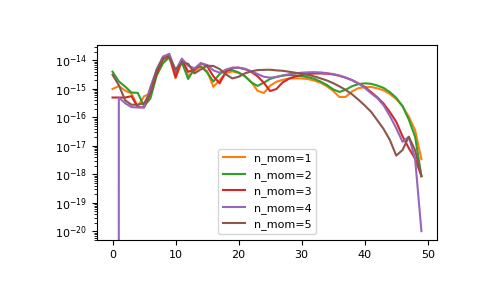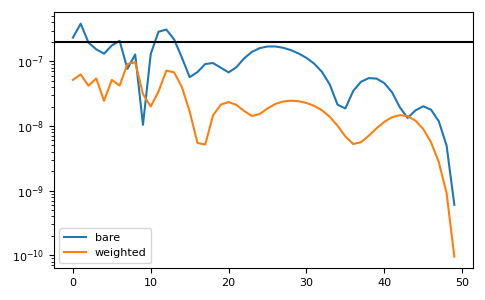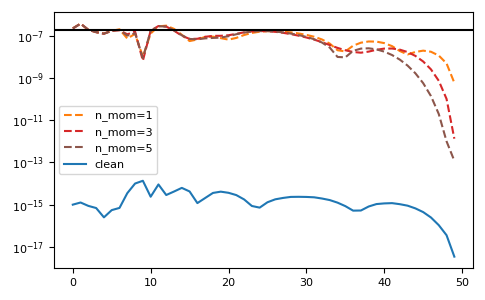gftool.fourier.tau2izp¶
-
gftool.fourier.tau2izp(gf_tau, beta, izp, moments=None, occ=False, weight=None)[source]¶ Fourier transform of the real Green’s function gf_tau to izp.
Fourier transformation of a fermionic imaginary-time Green’s function to fermionic imaginary Padé frequencies izp. We assume a real Green’s function gf_tau, which is the case for commutator Green’s functions \(G_{AB}(τ) = ⟨A(τ)B⟩\) with \(A = B^†\). The Fourier transform gf_iw is then Hermitian. If no explicit moments are given, this function removes \(-G_{AB}(β) - G_{AB}(0) = ⟨[A,B]⟩\).
TODO: this function is not vectorized yet.
- Parameters
- gf_tau(N_tau) float np.ndarray
The Green’s function at imaginary times \(τ \in [0, β]\).
- betafloat
The inverse temperature \(beta = 1/k_B T\).
- izp(N_izp) complex np.ndarray
Complex Padé frequencies at which the Fourier transform is evaluated.
- moments(m) float array_like, optional
High-frequency moments of gf_iw. If none are given, the first moment is chosen to remove the discontinuity at \(τ=0^{±}\).
- occfloat, optional
If given, fix occupation of Green’s function to occ. (default: False)
- weight(…, N_tau) float np.ndarray, optional
Weight the values of gf_tau, can be provided to include uncertainty.
- Returns
- gf_izp(N_izp) complex np.ndarray
The Fourier transform of gf_tau for given Padé frequencies izp.
See also
tau2iwFourier transform to fermionic Matsubara frequencies.
pole_gf_from_tauFunction handling the fitting of gf_tau
Notes
The algorithm performs in fact an analytic continuation instead of a Fourier integral. It is however only evaluated on the imaginary axis, so far the algorithm was observed to be stable
Examples
>>> BETA = 50 >>> tau = np.linspace(0, BETA, num=2049, endpoint=True) >>> izp, __ = gt.pade_frequencies(50, beta=BETA)
>>> poles = 2*np.random.random(10) - 1 # partially filled >>> weights = np.random.random(10) >>> weights = weights/np.sum(weights) >>> gf_tau = gt.pole_gf_tau(tau, poles=poles, weights=weights, beta=BETA) >>> gf_ft = gt.fourier.tau2izp(gf_tau, beta=BETA, izp=izp) >>> gf_izp = gt.pole_gf_z(izp, poles=poles, weights=weights)
>>> import matplotlib.pyplot as plt >>> __ = plt.plot(gf_izp.imag, label='exact Im') >>> __ = plt.plot(gf_ft.imag, '--', label='FT Im') >>> __ = plt.plot(gf_izp.real, label='exact Re') >>> __ = plt.plot(gf_ft.real, '--', label='FT Re') >>> __ = plt.legend() >>> plt.show()

Results of
tau2izpcan be improved giving high-frequency moments.>>> mom = np.sum(weights[:, np.newaxis] * poles[:, np.newaxis]**range(6), axis=0) >>> for n in range(1, 6): ... gf = gt.fourier.tau2izp(gf_tau, izp=izp, moments=mom[:n], beta=BETA) ... __ = plt.plot(abs(gf_izp - gf), label=f'n_mom={n}', color=f'C{n}') >>> __ = plt.legend() >>> plt.yscale('log') >>> plt.show()

The method is resistant against noise, especially if there is knowledge of the noise:
>>> magnitude = 2e-7 >>> noise = np.random.normal(scale=magnitude, size=gf_tau.size) >>> gf = gt.fourier.tau2izp(gf_tau + noise, izp=izp, moments=(1,), beta=BETA) >>> __ = plt.plot(abs(gf_izp - gf), label='bare') >>> gf = gt.fourier.tau2izp(gf_tau + noise, izp=izp, moments=(1,), beta=BETA, ... weight=abs(noise)**-0.5) >>> __ = plt.plot(abs(gf_izp - gf), label='weighted') >>> __ = plt.axhline(magnitude, color='black') >>> __ = plt.legend() >>> plt.yscale('log') >>> plt.tight_layout() >>> plt.show()

>>> for n in range(1, 7, 2): ... gf = gt.fourier.tau2izp(gf_tau + noise, izp=izp, moments=mom[:n], beta=BETA) ... __ = plt.plot(abs(gf_izp - gf), '--', label=f'n_mom={n}', color=f'C{n}') >>> __ = plt.axhline(magnitude, color='black') >>> __ = plt.plot(abs(gf_izp - gf_ft), label='clean') >>> __ = plt.legend() >>> plt.yscale('log') >>> plt.tight_layout() >>> plt.show()
